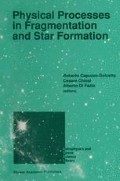Abstract
A large number of fully three dimensional (3D) calculations of the collapse of low mass protostellar clouds, performed with both finite difference and smoothed particle hydrodynamics codes, have shown that isothermal protostellar clouds usually fragment during collapse into binary or higher order protostellar systems. This dynamical fragmentation requires, however, starting the collapse phase from an initial cloud that is less centrally condensed than ρ i ∝ r −1 and that has appreciable specific angular momentum (J/M > 2 × 1020 cm2 s−1). 3D calculations of fragmentation in the nonisothermal regime (ρ > 10−13 g cm−3 of low mass protostellar collapse have shown that while fragmentation can still occur under certain conditions, the nonisothermal regime generally marks the beginning of the cessation of fragmentation. This occurs because rising temperatures result in increased ratios of thermal to gravitational energy, stifling thermally driven fragmentation. The minimum protostellar mass formed by the collapse and fragmentation of Population I clouds appears to be ~ 0.01 M ⊙. Increased thermal support leads to the formation of rotationally flattened, triaxial, quasi-equilibrium protostellar cores that are the 3D analogues of the 1D cores found by Larson (1969). Protostellar cores may be either relatively large, outer cores, supported by molecular hydrogen, or relatively small, inner cores, supported by atomic and ionized hydrogen. Rotationally-driven fragmentation also appears to be stifled in these quasi-equilibrium cores, because angular momentum transport by spiral structure leads to orbital decay of any nascent binary structure, as found in calculations of the dynamic fission instability in rapidly rotating polytropes.
Access this chapter
Tax calculation will be finalised at checkout
Purchases are for personal use only
Preview
Unable to display preview. Download preview PDF.
References
Adams, F., Ruden, S., and Shu, F. 1989, preprint.
Benz, W. 1984, Astr. Ap., 139, 378.
Black, D. C., and Bodenheimer, R 1975, Ap. J., 199, 619.
Black, D. C., 1976, Ap. J., 206, 138.
Bodenheimer, R 1978, Ap. J., 224, 488
Bodenheimer, R, and Boss, A. P. 1981, M.N.R.A.S. 197, 477
Bodenheimer, P., Tohline, J. E., and Black, D. C. 1980, Ap. J., 242, 209.
Boss, A.P. 1980a, Ap. J., 236, 619.
Boss, A.P. 1980b, Ap. J., 237, 866.
Boss, A.P. 1981a, Ap. J., 246, 866.
Boss, A.P. 1981b, Ap. J., 250, 636.
Boss, A.P. 1984, Ap. J., 277, 768.
Boss, A.P. 1985, Icarus, 61, 3.
Boss, A.P. 1986, Ap. J. Suppl., 62, 519.
Boss, A.P. 1987, Ap. J, 319, 149.
Boss, A.P. 1988, Comm. Ap., 12, 169.
Boss, A.P. 1989a, Publ. Astr. Soc. Pac., 101, 000.
Boss, A.P. 1989b, Ap. J., 346, 000.
Boss, A. P., and Bodenheimer, P. 1979, Ap. J., 234, 289.
Cassen, P. M., Smith, B. F., Miller, R. H., and Reynolds, R. T. 1981, Icarus, 48, 377.
Cook, T. L., and Harlow, F. H. 1978, Ap. J., 225, 1005.
Dorfi, E. 1982, Astr. Ap., 114, 151.
Durisen, R. H., Gingold, R. A., Tohline, J. E., and Boss, A. R 1986, Ap. J., 305, 281.
Gingold, R. A., and Monaghan, J. J. 1977, M.N.R.A.S., 181, 375.
Gingold, R. A., and Monaghan, J. J. 1981, M.N.R.A.S., 197, 461.
Gingold, R. A., and Monaghan, J. J. 1982, M.N.R.A.S., 199, 115.
Gingold, R. A., and Monaghan, J. J. 1983, M.N.R.A.S., 204, 715.
Hayashi, C., Narita, S., and Miyama, S. M.1982, Prog. Theor. Phys., 68, 1949.
Hoyle, F. 1953, Ap. J., 118, 513.
Hunter, C. 1962, Ap. J., 136, 594.
Larson, R. B. 1969, M.N.R.A.S., 145, 271.
Larson, R. B. 1972, M.N.R.A.S., 156, 437.
Larson, R. B. 1978, M.N.R.A.S., 184, 69.
Low, C., and Lynden-Bell, D. 1976, M.N.R.A.S., 176, 367.
Lucy, L. B. 1977, Astron. J., 82, 1013.
Miyama, S. M., Hayashi, C., and Narita, S. 1984, Ap. J., 279, 621.
Monaghan, J. J., and Lattanzio, J. C. 1985, Astr. Ap., 149, 135.
Monaghan, J. J., and Lattanzio, J. C. 1986, Astr. Ap., 158, 207.
Narita, S., and Nakazawa, K. 1977, Prog. Theor. Phys., 59, 1018.
Norman, M. L., and Wilson, J. R. 1978, Ap. J., 224, 497.
Rees, M.J. 1976, M.N.R.A.S., 176, 483.
Röżyczka, M., Tscharnuter, W. M., and Yorke, H. W. 1980, Astron. Ap., 81, 347.
Shu, F. H., Adams, F. C., and Lizano, S. 1987, Ann. Rev. Astr. Ap., 25, 23.
Tohline, J. E. 1980, Ap. J., 235, 866.
Tscharnuter, W. M. 1987, in Physical Processes in Comets, Stars, and Active Galaxies, eds. E. Meyer-Hofmeister, H. C. Thomas, and W. Hillebrandt (Berlin: Springer-Verlag), p. 96.
Williams, H. A. 1988, Thesis, Louisiana State University, Baton Rouge.
Williams, H. A., and Tohline, J. E. 1987, Ap. J., 315, 594.
Williams, H. A., and Tohline, J. E. 1988, Ap. J., 334, 449.
Wood, D. 1981, M.N.R.A.S., 194, 201.
Wood, D. 1982, M.N.R.A.S., 199, 331.
Author information
Authors and Affiliations
Editor information
Editors and Affiliations
Rights and permissions
Copyright information
© 1990 Kluwer Academic Publishers
About this paper
Cite this paper
Boss, A.P. (1990). Fragmentation of Isothermal and Nonisothermal Protostellar Clouds. In: Capuzzo-Dolcetta, R., Chiosi, C., di Fazio, A. (eds) Physical Processes in Fragmentation and Star Formation. Astrophysics and Space Science Library, vol 162. Springer, Dordrecht. https://doi.org/10.1007/978-94-009-0605-1_24
Download citation
DOI: https://doi.org/10.1007/978-94-009-0605-1_24
Publisher Name: Springer, Dordrecht
Print ISBN: 978-94-010-6760-7
Online ISBN: 978-94-009-0605-1
eBook Packages: Springer Book Archive

